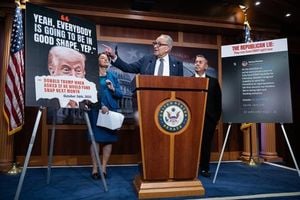In a week packed with high-stakes diplomacy and economic maneuvering, the Asia-Pacific region found itself at the heart of a shifting global order. On October 31, 2025, two scenes unfolded just miles apart, yet worlds away in their symbolism: U.S. President Donald Trump departed South Korea after a whirlwind 24-hour visit, while Chinese President Xi Jinping remained, settling in for the Asia-Pacific Economic Cooperation (APEC) summit in Gyeongju. The juxtaposition could hardly be sharper, as reported by Reuters and Yonhap, with China seizing the moment to project itself as the region’s new champion of multilateralism and free trade, while the United States, once the architect of the post-Cold War economic order, appeared increasingly withdrawn.
At the APEC summit, Xi Jinping made his intentions clear. "We must practice true multilateralism, and enhance the authority and effectiveness of the multilateral trading system with the WTO at its core," he told assembled leaders, according to Reuters. His remarks, aimed at updating international economic and trade rules to better protect developing countries, were a direct contrast to Trump’s America First policies, which have prioritized bilateral deals and raised barriers to trade across the region.
While the U.S. sent Treasury Secretary Scott Bessent as its representative, President Trump’s absence from the APEC gathering marked a dramatic reversal in American engagement with an institution it helped found in 1989. The move did not go unnoticed. As Reuters described, Asian neighbors are increasingly concerned about both China’s growing economic dominance and the United States’ apparent retreat. The region, home to the world’s fastest-growing economies and critical supply chains, is now at the center of a contest for influence that feels more acute than ever.
Meanwhile, Trump’s own diplomatic blitz focused on bilateral meetings at the Association of Southeast Asian Nations (ASEAN) forum in Malaysia. There, he secured four trade deals, but none reduced U.S. trade barriers. In fact, some agreements included explicit threats: if a country deepens relations with another that "jeopardizes essential U.S. interests"—widely interpreted as a reference to China—it could face even more tariffs. As Reuters noted, these deals were seen as circumstantial and limited compared to China’s sweeping regional initiatives.
China, for its part, was not content to rest on rhetoric alone. Premier Li Qiang, during a visit to Kuala Lumpur the previous week, signed an upgraded China-ASEAN free trade agreement, further cementing Beijing’s economic ties with its neighbors. According to Yun Sun, co-director of the East Asia Program at the Stimson Center, "The upgraded free trade agreement only reinforces China's dominant posture in terms of regional economic engagement. In comparison, U.S. bilateral trade deals with individual countries are much more circumstantial and limited in their scope."
This assertiveness is not without its detractors. Many Asian nations remain wary of China’s muscular defense posture and its willingness to use economic leverage as a political tool. Japan’s foreign ministry spokesperson, Toshihiro Kitamura, was blunt: "China is very powerful, a big country in terms of economy, and they try to make use of these U.S. tariff issues in order to pretend as if they are the guardian or champion of the free trade system. But for Japan, it's not true. As I said, for example, the rare earths issue, they try to utilise their own resources in order to impose their positions on politics to others. So we don't think that they are champions of the free trade system."
The rare earths issue Kitamura referenced is no small matter. In October, China announced it would dramatically ratchet up restrictions on rare earth exports, a move that sent shockwaves through already brittle global supply chains. It’s a potent reminder of just how much leverage Beijing holds, and why its neighbors approach its overtures with a mix of pragmatism and unease.
Eric Olander of the China Global South Project summed up the dynamic: "China's strategy was through expanded trade, infrastructure development, and supply chain logistics to bind this region to the Chinese economy to the point where it eventually becomes totally unfeasible for countries to extricate themselves from their reliance on Chinese economic engagement." The long-term implications of such entanglement are not lost on policymakers from Seoul to Canberra.
On the security front, the week also saw a rare in-person meeting between U.S. Defense Secretary Pete Hegseth and Chinese Defense Minister Adm. Dong Jun on the sidelines of the ASEAN summit in Malaysia. Hegseth, in a social media post cited by multiple outlets, described the encounter as "good and constructive" but made it clear that the U.S. would "stoutly defend its interests" in the Indo-Pacific. He raised "serious concerns" about China’s activities in the South China Sea and around Taiwan, reiterating that while the U.S. does not seek conflict, it will ensure it has the capabilities to defend its interests in the region.
The Chinese Ministry of National Defense, in a statement after the meeting, struck a more conciliatory tone, asserting that a stable and positive relationship between the U.S. and Chinese militaries is possible. However, it also warned Washington against supporting Taiwan’s independence—a perennial flashpoint in U.S.-China relations. This comes after the Trump administration earlier in 2025 removed language from the State Department website stating the U.S. did not support Taiwan independence, a move that has complicated the already delicate status quo.
Hegseth, for his part, has not shied away from tough talk. At a defense conference in Singapore in May, he said, "There’s no reason to sugarcoat it, the threat China poses is imminent." He warned that any move by Beijing against Taipei "would result in devastating consequences for the Indo-Pacific and the world." Such rhetoric has drawn Chinese criticism, with officials accusing Hegseth of espousing a "Cold War mentality." Yet, the secretary has been unwavering: the U.S. will support its allies and not allow them to be "subordinated or intimidated."
These developments came just a day after Trump’s own meeting with Xi Jinping, where the two leaders agreed to scale back some tariffs. Still, the broader trajectory remains fraught. As Reuters and BBC have noted, the region is caught between a U.S. increasingly focused on transactional, bilateral deals and a China intent on re-writing the rules of the game in its favor.
Xi Jinping’s schedule in Gyeongju was packed—he planned further meetings with Canadian Prime Minister Mark Carney and Japan’s new Prime Minister Sanae Takaichi, both likely to be challenging given ongoing trade disputes and political differences. Meanwhile, back in Washington, Trump returned to a more familiar scene, hosting the White House’s annual Halloween party with First Lady Melania Trump.
For now, the Asia-Pacific’s future remains uncertain, perched between two visions of order. One thing’s for sure: the balance of power, both economic and strategic, is in flux—and the world is watching closely.



